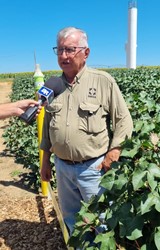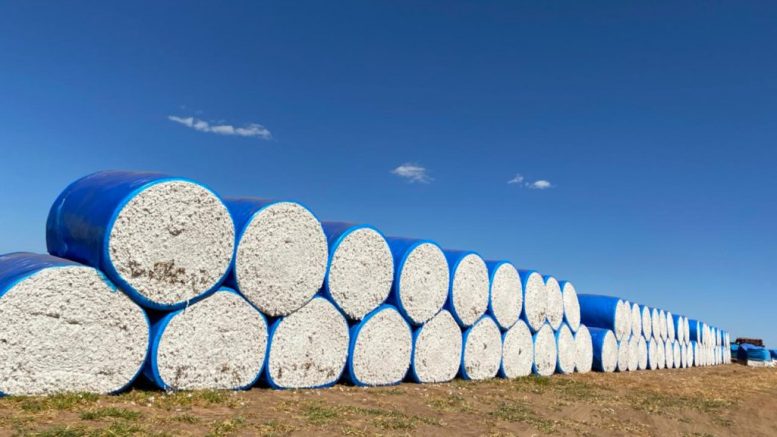“The growth in the cotton area occurred due to several factors: improved profitability of the crop, compared to soybeans and corn; loss of many early soybean crops…”
Eleusio Curvelo Freire is a consultant at Cotton Consultoria, with a degree in agronomic engineering from the Federal University of Paraíba, a M.Sc. in agronomy from the Federal University of Ceará, and Ph.D. in genetics and plant breeding from Esalq.
Freire was a researcher at Embrapa for 34 years in the area of cotton breeding and general head of Embrapa Cotton.

Eleusio Freire, consultant at Cotton Consultoria
AgriBrasilis – Cepea has estimated a 2.5% drop in cotton crop yields this season. What are the main enemies of cotton yields?
Eleusio Freire – The agricultural year was climatically governed by El Niño, which caused episodes of drought and high heat in the States of São Paulo and Paraná. In the Northeast (Matopiba region, which are the States of Maranhão, Tocantins, Piauí, and Bahia) and in the State of Mato Grosso, El Niño forced farmers to carry out several replantings, causing crops to develop unevenly. This low “plantability”, associated with the high temperatures recorded in November and December, should result in yield losses.
AgriBrasilis – The cultivated area grew 16.3%. What is motivating the farmer to plant more? Is there room for more growth?
Eleusio Freire – The growth in the cotton area occurred due to several factors: improvement in the profitability of the crop, when compared to soybeans and corn; loss of many early soybean crops in the State of Mato Grosso (main producer in Brazil) due to the dry spells caused by El Niño, inducing farmers to replace soybean crops with cotton, aiming to recover the profitability of the areas, as the climate risk continues for off-season corn, mainly because of droughts; increase in exports expected for 2024, when Brazil will assume the position of the world’s largest cotton exporter.
There is room for more growth. The Brazilian Cotton Farmers Association – Abrapa has carried out excellent marketing and sales work abroad, where more than 2/3 of national production is currently directed. Brazilian cotton meets the quality and price requirements demanded by Asian importers, who are our main customers.
“In this system, and without crop rotation, it is not efficient to spray borders, because the boll weevil is already within the areas, which forces farmers to perform many applications against the boll weevil”
AgriBrasilis – What is the incidence scenario of the boll weevil (Anthonomus grandis)? Why was there such a sharp increase in the population of this insect in the State of Mato Grosso?
Eleusio Freire – Cotton farmers in Brazil decided to coexist with the boll weevil, while farmers in the USA, for example, decided to eradicate this pest.
Coexistence with the boll weevil in Brazil is specific to each producing State: Maranhão, Piauí, Paraná and Minas Gerais have a lower cost of cohabitation due to insect control practices at the implementation of the crops, during the crops development and when the insects exit the crops, associating this with crop rotation and border control.
In the case of the State of Mato Grosso, the largest national producer, cotton farming predominates in the off-season, after succession with early soybeans. Crop rotation is less practiced in the State of Mato Grosso, and farms are practically always using the early soybean – cotton – early soybean system. There are many cotton volunteer plants left in the middle of the early soybean crops, where the boll weevil grows. These insects infest cotton crops that are planted later. In this system, and without crop rotation, it is not efficient to spray borders, because the boll weevil is already within the areas, which forces farmers to perform many applications against the boll weevil.
Another example is in the State of Bahia, the second largest national producer, where off-season cotton is not planted, but crop rotation is less practiced, border spraying is done late and the boll weevil is not controlled at the exit of the fields, allowing large populations of the insect to survive from one agricultural year to the next. Therefore, this State also requires a high number of insecticide applications.
AgriBrasilis – How is boll weevil control carried out and how much does it cost farmers?
Eleusio Freite – In the States of Maranhão, Piauí, Minas Gerais and Paraná, control begins with the use of the following techniques: crop rotation, border spraying from the first week onwards, applications in the total area in the bud phase and during defoliation, control of weevils at the exit of crops with weevil killer tubes or border spraying. In these regions, 10 to 20 border sprays are made, which correspond to 3 to 4 applications in the total area and 3 more general applications, totaling 4 to 7 applications per harvest, which cost less than US$ 100.00 per hectare. This way, production is not lost due to damages to the crop.
In the States of Bahia and Mato Grosso, border spraying is not carried out, or it is carried out late, with no practical effect. Spraying is always carried out in batches of 3 to 4 sequential applications and the weevils are not controlled when leaving the crops, leaving many insects for the following harvest, which survive inside soybeans or corn, or even in plants in the Cerrado biome. The number of applications is high, above 15, and costs approximately US$ 200.00 per hectare.
AgriBrasilis – The main cotton disease is Ramularia. What are the damages and losses caused by this fungus? How is control carried out?
Eleusio Freire – Ramularia is already being well controlled through the use of resistant varieties and 4 to 6 applications of fungicides in a preventive and curative manner. This fungus causes the middle and lower leaves of the plants to fall. Furthermore, it can cause cotton boll rot, among other symptoms.
Today the biggest disease problem in cotton is caused by nematodes (Meloydogine and Rothilenchulus), and target spot [caused by the fungus Corynespora cassiicola]. Nematodes are controlled through crop rotation and resistant varieties, and the target spot can only be controlled with the use of multisite fungicides, applied preventively.
AgriBrasilis – What advantages are there when including cotton in the soybean-corn system?
Eleusio Freire – The main advantage is in loosening the soil and allowing for efficient crop rotation. The continuous use of the soybean – off-season corn system for decades resulted in the compaction of the surface layers of the soil (between 10 and 20 cm), which makes crops more sensitive to dry spells and waterlogging.
The soils, when prepared for cotton, are decompacted, limed and agricultural plaster is applyed, to enable high yield farming. When the farmer plants soybeans and corn in rotation with cotton, yields increase up to 15% (approximately 10 bags of soybeans and up to 25 bags of corn) per hectare.
Another advantage of including cotton is improved efficiency in disease control and increased soil organic matter. The most efficient rotation that has been observed should be done as follows: planting soybeans, followed by decompacting the soil and planting corn associated with Brachiaria, to plant cotton on the Braquiaria straw in the following harvest.
The benefits of Brachiaria straw for cotton are the reduction of nematodes, reduction of the severity of diseases such as Ramularia, target spot and white mold [caused by the fungus Sclerotinia sclerotiorum], improvement of weed control and the quality of the cotton obtained.
READ MORE:

